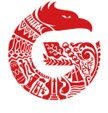Exploring Kerinci
The word Kerinci may remind one of Mount Kerinci and Kerinci Lake, the two tourist icons of Kerinci regency, Jambi. But there is more to find and explore.
A monument called Tugu Macan is located at the climbing path to Mount Kerinci. — Photo by Syofiardi Bachyul Jb.
If you have plenty of time, there are countless tourist attractions and adventure sites waiting to be explored.
Popular sites can be found in the Kerinci Seblat National Park (TNKS), which lies mostly inside the regency. Climbing 3,805-meter Mt. Kerinci, the country’s largest volcano and Sumatra’s highest peak, is also an option.
Tourists can also visit Gunung Tujuh Lake, the highest in Southeast Asia at 1,996 meters, which takes four hours to reach by climbing and is surrounded by seven peaks. Or you can go bird watching at Ladeh Panjang, the island’s highest peatland forest.
Kerinci Lake — Photo by Syofiardi Bachyul Jb.
Another attraction is Kaca Lake, located near Kerinci Lake, which small in size but reflects colorful stones found at the bottom of the lake.
Adventurous tourists can visit Kasah cave, considered sacred by residents, who believe it was once the home of their ancestors.
Although exploring Kerinci takes time, it does not mean those on short vacations must miss the place’s beauty.
Kerinci is now divided into two, a municipality and regency. Kerinci City covers area which size is just a little bit bigger than the capital of the old regency, Kota Sungai Penuh. Although both administrations are under Jambi province, they are closer and easier to reach from the West Sumatran capital of Padang.
It takes six to seven hours to drive from Padang to Sungai Penuh. From Sungai Penuh, it will take 10 more hours to reach Jambi City through small and damaged roads.
The trip from Padang to Sungai Penuh will not be boring since several tourist sites are located near the highway.
Telun Berasap waterfall – Photo by Syofiardi Bachyul Jb.
On the border of South Solok regency in West Sumatra and Kerinci regency, one can spot the Telun Berasap waterfall, which is within the national park area. It is located just 200 meters from the highway.
The waterfall, which originates from Gunung Tujuh Lake, is 20-meters high and its splashes send mist into the air. When the sun shines brightly, rainbows can surround the waterfall, creating breathtaking views.
From there, one can also see three peaks, including Mt. Kerinci, whose blackened peak was visible from afar on a clear day, while green vegetable farms frame the roadside.
About 40 kilometers from Sungai Penuh, a vast tea plantation of 2,500 hectares blankets the area.
The plantation is one of the world’s oldest, with its black tea crops first planted by Dutch company Namlodee Venotchaat Handle Verininging Amsterdam (NV HVA) in 1928.
Unlike in the past, when passersby could see farmers working on plantation, modernization has replaced humans with machine. Some old trees had also be replaced with new tea varieties.
Tea plantation turn roadsides at Kayu Aro green with Mount Kerinci as a backdrop. – Photo by Syofiardi Bachyul Jb.
On Saturdays, visitors can also see the Kersik Tuo marketplace buzzing with activity, with traders spilling on to the street with Mt. Kerinci in the backdrop.
After leaving the tea plantation, 18 kilometers closer to Sungai Penuh, is Lubuk Nagodang where dozens of shops and stalls fill both sides of the road, selling Kerinci’s signature snacks, such as dodol kentang, (potato sweets).
Just before entering Sungai Penuh City, one passes Semurup hot spring, which originates with Mt. Kerinci, where many tourists spend time bathing, buying eggs and bananas boiled in the spring.
Sungai Penuh City, though small, is one of the country’s cleanest cities and regularly wins the Adipura Award.
An old wooden mosque, with no windows but covered by carvings, lends to the unique atmosphere in the city. In front of the Great Pondok Tinggi mosque, built in 1874, the visitors can see a rumah panjang, a traditional long house. Such houses were usually built by clans in Kerinci, with one house divided into more than 10 sections.
Pondok Tinggi Grand Mosque — Photo by Syofiardi Bachyul Jb
Kerinci is also one of 11 regions across the country which has its own alphabet, known as Aksara Kerinci or Incung, which still can be spotted written under road signs.
The popular Kerinci Lake itself is located 16 kilometers south of Sungai Penuh. The 4,200-hectare lake, which lies at a height of 650 meters, is the host of the annual Kerinci Lake Festival, held every July to showcase the city’s traditional cultural performances.
Kerinci itself is home to 15 lakes but Kerinci and Gunung Tujuh are the biggest. Smaller lakes include Belibis, Lingat and Kaca. The place is also rich in history, with several menhir standing stones and other cylindrical stones unearthed near Kerinci Lake.
Experts believe that several locations in Kerinci, mainly around the lake, are historical sites, proven through the finding of several ancient stone axes and pieces of obsidian, a natural stone of volcanic origin with a glass-like appearance found in a wide range of stunning natural colors. Unfortunately, no archeological excavation has been made.
With its natural beauty, rich culture and history, Kerinci is a rare gem waiting to be discovered.
Getting there
• Besides car, one can visit Kerinci from Jambi by air. A small 50-seat airplane serves the one-hour route three times a week, arriving at Depati Parbo airport, some 15 kilometers from Sungai Penuh City, at the cost of Rp 350,000.
• A bus trip from Padang to Sungai Penuh costs Rp 70,000 a person, with the bus leaving on daily basis twice a day, at 9 a.m. and 7 p.m., for the 7-hour trip. A bus trip from Jambi to Sungai Penuh costs Rp 150,000 for a 10-hour trip.
• Rental cars from Padang offer the best option. Better to start the trip in the morning and reach Kerinci by afternoon. By car, one can enjoy more scenery and stop to visit tourist attractions along the way.
News source: The Jakarta Post







No response